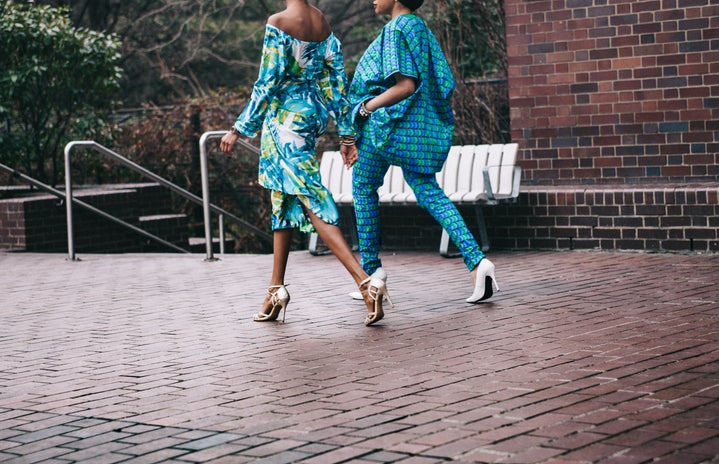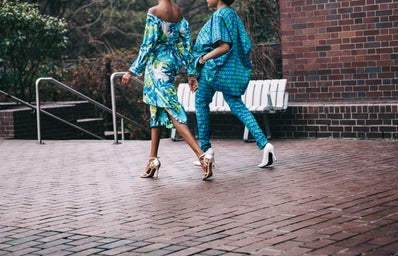The little black dress has always been a staple in life. No matter if you like to dress up or not you most likely have one hanging in your closet just waiting to be worn for a special event or occasion. Why is the LBD such a big deal? Why is it always our go to? Black dresses will always be considered classic and chic, because there’s no way wearing black can ever go wrong. The beauty of being able to pile on layers of jewelry, or being able to wear many other colors and patterns with black is what makes the LBD so easy and fun compared to colorful dresses (in my opinion; I only wear black.)
But the little black dress wasn’t always popular — in fact, the color black was worn only for funerals and for mourning until the early 1900’s, when artist John Singer Sargent painted his “Madame X.” The woman wears a gown that tumbles to the floor, and has a heart shaped bodice that is garnished with golden straps. The dress caused a lot of controversy for being too “sexy” at the time, and was then forgotten about, until the 1920’s.
1920’s
In October of 1926, Vogue introduced Chanel’s Ford Dress to the women of the United States stating that the dress would be the “frock that all the world will wear,” the dress became popular because of its easy fit and how it complimented all different body types. It was also loved for its simplicity, which Chanel wanted to focus on. The dress was plain and tomboyish, but also risqué at the time for its calf length. It brought to light the change in how women went from dressing in long, heavy clothing that took hours to put on, to being able to slip on a dress and walk right out of the home for an evening out. Although Chanel might not have introduced the flapper dress to society in the 20’s it still brought the trend of wearing black to be elegant and cordial.
1930’s
By the 1930’s the little black dress became a staple for simple eveningwear. Designers such as Elsa Schiaparelli (Chanel’s rival) saw the popularity of the LBD growing, and threw in their own ideas and designs, such as Schiaparelli’s wrap dress. The cartoon character Betty Boop became popular at this time wearing extremely short and tight dresses-which were never worn at the time- and created an even bigger name for the LBD. Little black dresses were still at calf length, but were nevertheless changing. The dresses became more feminine by embracing the curves of women, making the dresses more fitted, and also brought a certain playfulness by lightly layering and adding teasing sleeves of sheer and feathery cloth.
1940’s
During World War 2 the importance of looking fashionable dimmed. Fabric was mainly being used to create uniforms and necessary clothing instead of going towards fabric designs for evening gowns and lavish outfits. However, fashion was never forgotten and the LBD made its way through the war regardless of the conditions. Less fabric was used to make the black dresses causing the dresses to be knee length, and simpler patterns and designs were created so that the dresses were neither too plain or too fancy. The LBD became more conservative at this time, but could be worn to any occasion by accessorizing it with different jewelry and accessories.
1950’s
After the war, the imagination and talent of many designers went back into little black dresses. Glamorous designs came into play during the 1950’s, with tight bodices that lead to full, bouncy skirts creating a beautiful bell like shapes. Straps came off the shoulders, and dresses were tightly wrapped around the curves and legs of women like never before. The 50’s were filled with variety for the little black dress. It was also the time in which the LBD started moving away from its traditional structure and layout and became more of a sexy, unique dress. The 50’s would change the idea of the LBD forever.
1960’s
The little black dress was the most popular in the 1960s, of course most of us have all seen Breakfast At Tiffany’s with Audrey Hepburn, and we all know that her character Holly Golightly is still a major symbol in fashion for her array of solid black dresses. The 60’s brought along shorter dresses with simple styles, and a sense of modernness. Geometric patterns could be found with straight lines and sharp angles. The LBD was supposed to be subtle but eye-catching, elegant but simple. The LBD of the 60’s was mirrored the flapper-esque styles of the 1920’s, which was accomplished by adding lace, beads, and fringe to dresses. Later in the 60’s dresses became shorter and shorter adding playfulness and energy to a young woman’s wardrobe.
1970’s
The Little Black Dress was probably least popular in the 1970’s. During the decade of disco, bright colors and sparkling pants were all in, and the dark dress would not be found in dance clubs and social events. However, the LBD was embraced by punk rock culture. Creativity sparked in the minds of this rebellious group while they created edgy and goth like looks. LBD’s would be ripped, pinned, patched and more by using various materials even including plastic bags! Many people wore their dresses with fishnets, and wore accessories that made the little black dress seem more intense and grown-up.
1980’s
This bubbly and expressive time period brought back the elegance, but also kept the edginess of the 1970’s little black dress. Broad shoulders and strong embellishments such as sequins and rhinestones brought some sparkle and life to the LBD. The dresses were dazzling with their playful frills and spreading layers, and designers put their imagination into making products that were innocent, but also sexy. Icons such as Madonna kept the styles of punk alive, continuing the trend of ripping, pinning, and wearing of clothing. In a way, this symbolized not only the youth of the generation, but also the freedom in which they were searching for. Very much like the women who turned to the LBD in the 1920’s.
1990’s
The decade of grunge led the LBD back to it’s origins of being plain and simple. Dresses were normally solid black with no patterns or designs, were tight and short, and usually had very simple sleeves such as spaghetti straps. Dresses started having plunging necklines and skin was more exposed not only by a shorter hemline, but also with cutouts in the fabric along the body of the dress. The make-up of the 90’s intensified the look of the LBD and made it look effortless but stylish.
2000’s
Today, we find many different styles and designs of little black dresses that reflect past trends. LBD’s can be either very simple or elegant depending on what you are looking for or where you go to shop. Many LBD dresses that have been popular in the past few years are the bandeau, baby doll party dresses, and bodycon fit. However, we find that the most popular LBD’s are the ones that remind us of past icons and role models. The LBD will never become old or boring because of it’s classic role in the past 100 years. Hopefully our generation will contribute to the minds of the next generations in the years to come, and will continue to make the little black dress more than memorable.

